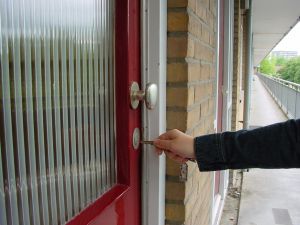Posted by Teresa on May 29, 2010 under Landlord Tips, Tenant Screening & Background Checks | 
 You’ve advertised your vacant rental property, had some calls of interest, and pre-screened the callers to weed out those that aren’t best-fit tenants for you.
You’ve advertised your vacant rental property, had some calls of interest, and pre-screened the callers to weed out those that aren’t best-fit tenants for you.
Now, you’re ready to show the property in person. Here are a few tips for a successful showing of your rental property:
If you can, schedule an open house to show your rental property to multiple applicants. Not only is it easier on you than running back and forth several times, it also helps create a sense of urgency in the potential tenants. When they see other interested parties, they might be more willing to sign a lease sooner, rather than later.
If you don’t have enough prospective tenants for an open house, you can still try to schedule appointments back-to back, to maximize your time. Of course, you can’t expect your potential tenants to alter their schedules to suit yours; but suggesting a time that works for you is fine—even if it just so happens to be right before or after another showing.
When setting up appointments, get a couple of ways to reach the prospective tenant. If the appointment is several days out, give them a call or drop an email a day ahead, or even the day of, to confirm the appointment. It’s better to take a few minutes to do so than to waste time on no-shows.
Be careful when showing your rental property. Setting up a time to meet a complete stranger is always risky; be smart, be alert, and if possible, don’t go alone—especially if the appointment is after dark or in a shaky neighborhood. You can even meet the prospective tenant in a public place first, then proceed to the rental property. Take precautions—don’t carry cash or credit cards, or wear expensive jewelry. If you ever feel unsafe during the showing, grab your cell phone, call a friend, and walk out.
Assuming most potential tenants mean you no harm, put on your best smile and be 100% professional when meeting them. Greet them warmly, shake their hand, and make eye contact. Introduce yourself and learn their name—even ask for the spelling if you’re unsure of how to pronounce it. Refer to the notes you took during your phone conversations, so the potential tenant feels important.
Don’t let the prospective tenant wander through your rental property on their own. This is a showing, so show it off! Point out the features and benefits of living there. Listen carefully and answer their questions thoroughly.
Pay attention to the first room the potential tenant heads for—this indicates which room is most important, so be sure to describe its best features. If they head for the kitchen, don’t steer them into the bedroom. Take as much time as they need to talk about the kitchen.
Make sure you don’t skip the garage, storage areas, and yard. Take them to the fitness and laundry rooms, and the children’s play area. Be sure that every potential tenant gets the full tour—you could be inadvertently sending discriminatory signals if you do not.
For vacant rental units, a few pieces of furniture helps potential tenants mentally place their own sofa, loveseat, or bedroom suit in the space—taking care of any concerns the apartment or living room is too small.
And encourage the potential tenant to submit a rental application before they leave. Gather all the information you need to run a tenant background check, and you may just have a new tenant for your vacant rental unit!
Posted by Teresa on December 8, 2009 under Screening and Background Checks, Tenant Credit Checks, Tenant Screening & Background Checks | 
 Tenant screening involves conducting background checks on potential tenants. Typical checks include tenant credit check, criminal background check, and tenant rental history. Landlords and rental property managers also have the option to check previous addresses, identity and name validation, address validation, evictions, liens, bankruptcies, and sex offender status.
Tenant screening involves conducting background checks on potential tenants. Typical checks include tenant credit check, criminal background check, and tenant rental history. Landlords and rental property managers also have the option to check previous addresses, identity and name validation, address validation, evictions, liens, bankruptcies, and sex offender status.
Here are some dos and don’ts to consider when making the decision to screen tenants:
- Do keep the screening process consistent: screen every applicant, every time.
- Don’t make yourself vulnerable to discrimination suits by screening applicants based on appearance or other subjective attributes.
- Don’t skip the tenant screening for an applicant who speaks well or dresses nicely, or the tenant applicant who drives a nice car—again, these are subjective observations that do not mean they will pay rent on time.
- Do protect your other tenants and the neighbors surrounding your rental property by including criminal history in your background check process.
- Do choose your screening service carefully. Are they a Better Business Bureau Accredited Business and Fair Credit Reporting Act (FCRA)-Compliant Consumer Reporting Agency? Is the staff FCRA Certified and Bonded?
- Do ensure that your screening service employs high security measures, such as fingerprint scanners, controlled access, monitored facilities, and proper disposal techniques.
- Don’t use a screening service without nationwide coverage and access to all three credit bureaus.
- Do keep all information learned from a tenant credit report in strictest confidence.
- Don’t neglect to provide a tenant applicant with a copy of the report, and to advise them in writing if you reject them for credit reasons.
Posted by Teresa on September 21, 2009 under Screening and Background Checks, Tenant Credit Checks, Tenant Screening & Background Checks | 
 It’s rather difficult to find anyone who has not been affected by the economic troubles of the past year. That includes people who want to be your tenants. What should you look for when running tenant credit checks these days? If everybody’s credit is bad, why bother to do a credit check? Should landlords and property managers lower their standards in light of the rise in rental vacancies? Read on for answers to these questions.
It’s rather difficult to find anyone who has not been affected by the economic troubles of the past year. That includes people who want to be your tenants. What should you look for when running tenant credit checks these days? If everybody’s credit is bad, why bother to do a credit check? Should landlords and property managers lower their standards in light of the rise in rental vacancies? Read on for answers to these questions.
Why bother with a tenant credit check when it’s going to be bad? Besides, if I skip it, I save money, right? Actually, the money you invest by doing thorough tenant screening will more than pay for itself when you consider the long term cost of evicting and/or cleaning up after bad tenants. And believe it or not, lots of folks are making it through the down economy by spending less, saving more, and keeping their credit records clean.
Should I lower my standards? This is a tough rental market, with rents down and vacancies up. You must decide whether to keep your qualifying standards high—and face empty units—or take a chance by lowering them in order to fill your properties. Experienced landlords say that empty units are far better than renting to bad tenants. It all depends on your tolerance risk, your cash flow—and a lot of luck.
Can I ask why a prospective tenant has had a bankruptcy? Yes. There is no time like the beginning to start communicating clearly with your tenants. If there is a bankruptcy on the credit check, ask what happened. You may find out that medical bills forced the tenant into bankruptcy, or that an ex spouse was actually the cause. Of course, if the tenant has other red flags on the credit report, you must take them into consideration, too.
Take a wide-angle view of the tenant’s credit history. If a bankruptcy is several years in the past, and everything else checks out, they may be an acceptable risk. If the bankruptcy was due to a business failure, the economy could be to blame—not the tenant. Past evictions and utility judgments are a higher risk indicators to many landlords than bankruptcies.
Do not ignore your gut instinct. If someone seems untrustworthy, they very well might be. Only you can decide whether a poor credit score or bankruptcy is worth the risk. The important thing is to perform consistent tenant credit checks!
 You’ve advertised your vacant rental property, had some calls of interest, and pre-screened the callers to weed out those that aren’t best-fit tenants for you.
You’ve advertised your vacant rental property, had some calls of interest, and pre-screened the callers to weed out those that aren’t best-fit tenants for you.

